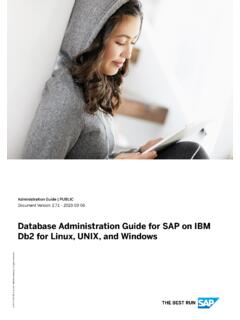Transcription of System Administrator Guide - OpenVPN
1 OpenVPN Access server System Administrator Guide COPYRIGHT NOTICE. Copyright OpenVPN Technologies 2010. OpenVPN Access server System Administrator Guide ii TABLE OF CONTENTS. 1 Introduction .. 2. Access server Deployment Topology .. 2. Access server Deployment Terminology .. 3. Deployment Overview (Quick Start) .. 4. 2 OpenVPN Access server Operation .. 5. Services and TCP/UDP Ports .. 5. Typical Network Configurations .. 5. One Network Interface on Private Network Behind the Firewall .. 6. Two Network Interfaces, One on Public and One on Private Network .. 6. One Network Interface on Public Network .. 7. User Authentication and Management.
2 8. Client Configuration Generation and 8. Virtual VPN Subnet Configuration .. 9. 3 Installation .. 10. Prepare the server .. 10. Obtain License Key .. 10. Install OpenVPN Access server RPM/DEB Package .. 10. Run ovpn-init .. 11. Configure Initial Admin Web UI Network Settings .. 12. Finalize the Initial Configuration .. 13. Configure Access server with the Admin Web UI .. 14. 4 Admin Web UI Reference .. 17. Status Pages .. 17. Status Overview .. 17. Log 18. Configuration Pages .. 20. License .. 20. server Network Settings .. 21. VPN Mode .. 24. VPN Settings .. 25. Advanced 28. User Permissions .. 32. Group 34. Authentication Pages.
3 35. 35. PAM .. 36. RADIUS .. 37. 38. Tools Pages .. 39. Profiles .. 39. Connectivity Test .. 41. 43. 5 Connect Client .. 44. Connect .. 45. 46. Rebranding the Admin UI .. 48. Certificates .. 49. server -locked Profile .. 51. OpenVPN Access server System Administrator Guide iii 6 Additional Information on RADIUS Support .. 51. RADIUS Authentication 51. RADIUS Accounting Attributes .. 51. 7 How to authenticate users with Active Directory .. 52. Configuring Access server LDAP Authentication .. 52. Specifying Additional Requirements for LDAP 53. 8 Failover .. 54. OpenVPN Access server System Administrator Guide iv 1 Introduction The OpenVPN Access server consists of a set of installation and configuration tools which allow for simple and rapid deployment of VPN remote access solutions using the OpenVPN open source project.
4 The Access server software builds upon the usability and popularity of OpenVPN , while easing VPN configuration and deployment by providing the following features: 1. Simplified server configuration Access server presents the Administrator with only the most useful of the many configuration options supported by the sophisticated OpenVPN server and clients. An easy-to-use, Web-based configuration interface makes setting up and maintaining the Access server deployment straight-forward and efficient. 2. Support for external user authentication database Rather than requiring you to create and manage credentials for each valid VPN user, OpenVPN Access server offers the ability to integrate with existing user authentication systems using one of the following: 1.
5 PAM1: the System for authenticating user accounts on the Unix server 2. an external LDAP or Active Directory server 3. one or more external RADIUS servers 3. Easy intuitive Web-Based client access Once a user fires up a Web browser they can then enter their credentials and connect to the VPN. In addition a user can download a pre-configured Windows installer for their Windows Operating System . Since the installer file was dynamically generated specifically for the user in question, that user can instantly connect to the VPN without need for additional client-side configuration. 4. Compatibility with a large base of OpenVPN clients An authenticated user can also download an OpenVPN client configuration file (also generated specifically for the user) from the Connect Client and use it with an OpenVPN .
6 + client other than the Windows GUI client. In this way, OpenVPN Access server is immediately compatible with OpenVPN clients running on non-Windows platforms, such as the Tunnelblick client on MacOSX and the Community Projects OpenVPN client on Unix/Linux. Of course, none of these benefits would matter without the robust security of client- server communication provided by OpenVPN s use of SSL/TLS. Access server Deployment Topology An OpenVPN Access server deployment consists of one server , many clients and many users, as depicted in Figure 1. Each client machine in this topology uses the public IP network (the Internet). to communicate with the OpenVPN Access server and thereby gains VPN-protected access to the private IP Network connected (if present).
7 1. PAM stands for Pluggable Authentication Modules, the common System for authenticating users on a Unix System . OpenVPN Access server System Administrator Guide 2. Figure 1: OpenVPN Access server Topology Access server Deployment Terminology The following terminology is used when referring to an OpenVPN Access server deployment: Term Definition OpenVPN Access server The OpenVPN server daemon along with the Access server s configuration and maintenance software running on a server computer. User An individual attempting remote access to private network resources via the public Internet. Client A computer (operated by a user) running OpenVPN client software in order to gain access to private network services via the OpenVPN Access server .
8 User Credentials A username and password used to authenticate a user. OpenVPN Desktop Client The OpenVPN Desktop client for Windows is a legacy client which has now for Windows been replaced by the Connect Client; however it is still available for users who need it. Client Configuration File A file which contains all of the information required for an OpenVPN client to securely connect to the OpenVPN server . User credentials are not included in the client configuration. Connect Client A client running on the Access server which delivers client configuration files and/or pre-configured Windows client installer files to authenticated users.
9 The Connect Client also allows for a user to login and connect through the browser. Admin Web UI A Web server running on the Access server which is used by the Administrator to configure the settings of the Access server . Table 1 Access server Deployment Terminology OpenVPN Access server System Administrator Guide 3. Deployment Overview (Quick Start). Setting up the OpenVPN Access server involves taking the following basic steps: 1. Determine the network configuration and IP addresses to use for server See Section for descriptions of typical network configurations. In short, you need to ensure that clients on the Internet can connect to the Access server (either via a public IP.)
10 Address on the Access server or via forwarding from a border firewall) and that the Access server is connected to the private network, if one is to be used. 2. Obtain a license key Register and sign in to to obtain an Access server license key. If you are evaluating this product, we have already allocated a two-user test key to the Access server . 3. Download and install the OpenVPN Access server package file Also from , download the appropriate binary package file for your server s particular version of Linux. Then (as root) install the package. For example, on Fedora/CentOS/RHEL: rpm -i and on Ubuntu: dpkg -i 4. Run ovpn-init to set initial configuration settings Post : By default the ovpn-init tool is already run after the package install.







